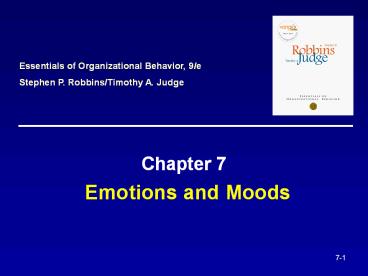Emotions and Moods - PowerPoint PPT Presentation
1 / 23
Title:
Emotions and Moods
Description:
Essentials of Organizational Behavior, 9/e Stephen P. Robbins/Timothy A. Judge Chapter 7 Emotions and Moods After studying this chapter, you should be able to ... – PowerPoint PPT presentation
Number of Views:3365
Avg rating:3.0/5.0
Title: Emotions and Moods
1
Emotions and Moods
Essentials of Organizational Behavior,
9/e Stephen P. Robbins/Timothy A. Judge
- Chapter 7
2
After studying this chapter, you should be able
to
- Differentiate emotions from moods.
- Discuss the different aspects of emotions.
- Identify the sources of emotions and moods.
- Describe external constraints on emotions.
- Discuss the impact emotional labor has on
employees. - Discuss the case for and the case against
emotional intelligence. - Apply concepts on emotions and moods to OB issues.
3
Why have emotions been excluded from OB study?
- Myth of rationality emotions were the
antithesis of rationality and should not be seen
in the workplace - Belief that emotions of any kind are disruptive
in the workplace
4
What are Emotions and Moods
- Affect a generic term that encompasses both
emotions and moods - Emotions intense feelings that are directed at
someone or something - Moods feelings that tend to be less intense
than emotions and often lack a contextual stimulus
5
Affect, Emotions and Moods
6
Aspects of Emotions
- Biology of Emotions emotions originate in the
brains limbic system, which is different for
each person - Intensity different people give different
responses to identical emotion-provoking stimuli - Frequency and Duration some emotions occur more
frequently and emotions differ in how long they
last
7
Aspects of Emotions (cont.)
- Emotions and Rationality Our emotions provide
important information about how we understand the
world around us. - Evolutionary Psychology states that we must
experience emotions because they serve a purpose
hard to know if this is valid all the time
8
Sources of Emotions and Moods
- Personality predisposes people to experience
certain moods and emotions. Affect intensity
affects the strength of the emotion - Day of week and Time of day more positive
interactions will likely occur from mid-morning
onwards and also later in the week
9
Day of Week Impact on Mood
10
More Sources
- Weather not an impact according to research
- Stress increased stress worsens moods
- Social Activities usually increase positive
mood and have little effect on negative mood - Sleep less sleep or poor quality sleep
increases negative emotions
11
More Sources
- Exercise enhances positive mood
- Age older people experience negative emotions
less frequently - Gender women show greater emotional expression,
experience emotions more intensely and display
more frequent expressions of emotions
12
External Constraints on Emotions
- Organizational Influences most American
organizations strive to be emotion-free - Cultural Influences cultures vary in
- Degree to which people experience emotions
- Interpretation of emotions
- Norms for the expression of emotions
13
Emotional Labor
- An employees expression of organizationally
desired emotions during interpersonal
transactions at work - Emotional dissonance is when an employee has to
project one emotion while feeling another one
14
Felt vs. Displayed Emotions
- Felt emotions are the individuals actual
emotions - Displayed emotions are those that the
organization requires workers to show - Surface acting is hiding our true emotions
- Deep acting is trying to change ones feelings
based on display rules
15
Emotional Intelligence
- Ones ability to detect and manage emotional cues
and information - Five dimensions
- Self-awareness
- Self-management
- Self-motivation
- Empathy
- Social skills
16
The case for EI
- Intuitive appeal it makes sense
- Evidence suggests that a high level of EI
predicts high job performance - Study suggests that EI is neurologically based
17
The case against EI
- EI is too vague a concept
- EI cant be measured
- EI is so closely related to intelligence and
personality that it is not unique when those
factors are controlled
18
OB Applications of Emotions and Moods
- Selection employers should consider EI a factor
in hiring for jobs that demand a high degree of
social interaction - Decision Making Positive emotions can increase
problem-solving skills and help us understand and
analyze new information
19
OB Applications of Emotions and Moods
- Creativity Positive moods increase creativity
- Motivation Organizations that promote positive
moods are likely to have a more motivated
workforce - Leadership Emotions help convey messages more
effectively
20
OB Applications of Emotions and Moods
- Interpersonal Conflict it is critical to
identify and work through the emotional elements
in any conflict - Negotiation emotions may impair negotiator
performance - Customer Service customers catch emotions
from employees, called emotional contagion
21
OB Applications of Emotions and Moods
- Job Attitudes emotions at work get carried home
but rarely carry over to the next day - Deviant Workplace Behaviors those who feel
negative emotions are more likely to engage in
deviant behavior at work
22
Implications for Managers
- Understand the role of emotions and moods to
explain and predict behavior - Emotions and moods can increase motivation
- Emotional labor recognizes that certain feelings
can be part of a jobs requirements - Intense emotions can interfere with performance
of complex jobs
23
Summary
- Differentiated emotions from moods.
- Discussed the different aspects of emotions.
- Identified the sources of emotions and moods.
- Described external constraints on emotions.
- Discussed the impact emotional labor has on
employees. - Discussed the case for and the case against
emotional intelligence. - Applied concepts on emotions and moods to OB
issues.































